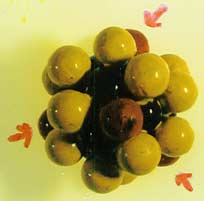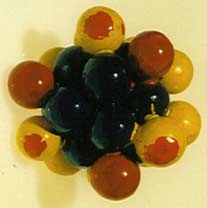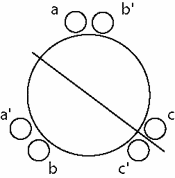by, Sithamalli K. Balasubramanian - Ph.D.
Abstract : A model for silicon based on the assumptions of the earlier paper is described for silicon. It is based on icosahedron. It accounts for the tetrahedral geometry of the atom. The model explains the formation of silicocene and the geometry of the molecule. Isotopic isomerism is postulated.
In part I we described a new concept for atomic structure and illustrated its usefulness with respect to the structural chemistry of Carbon {ref.1}. In this paper we extend the concept to Silicon to explain the chirality of quartz.
Though the chirality of quartz {ref.2} had been known for a long time it had been ignored and its significance to the theory of atomic structure had not been appreciated. Quartz consists of Si-O4 tetrahedra with the Si-O-Si angle being about 145º These are supposed to be arranged as right handed or left handed helices making the system chiral. The book is silent about the source of this information or the experimental evidence on which it is based. There are no special factors that would give rise to and stabilize such unusual arrangement. The helices are formed under special conditions. In linear systems strategically located hydrogen bonds lead to and hold the helix in its place. In some molecules like Hexahelicene, molecular overcrowding leads to a helical arrangement. Face sharing tetrahedra could arrange themselves in helical forms. Quartz has a three dimensional structure in which it is difficult to visualize a helix.
We have therefore to look for an explanation at the atomic level. In the earlier paper we had suggested the possibility that there could be a chiral relationship amongst the bonding sites, that is, the sites could arrange themselves in sets that are non-super-imposable images of each other. We have used this criterion and the tetrahedral geometry of Silicon to arrive at a structure for the element, using the major isotope 28Si for our purpose. ...top

Fig.1a - Silicon model. The arrows point to bonding areas.

Fig.1b - The ‘reverse’ face
of 1a. Full red colored areas are chiral to areas of two colors.
28Si is built upon a 12-nucleon icosahedron. The other 16 nucleons are distributed on the icosahedral base to give a dodecahedron with four vacant corners. Only four of these would satisfy the tetrahedral condition. These have two sets of six nucleons along the equatorial belt of the icosahedron. The six nucleons are arranged in three pairs. The arrangement of the remaining four nucleons leads to four different structures which satisfy the demands of Silicon structure. The simplest of these carries all the four nucleons on one side of the equatorial belt as shown in photos (1a) & (1b). The first photo shows the apex and the three pairs of nucleons of the lower equatorial belt (marked by arrows) that together could form two tetrahedra. The base of one such tetrahedron is shown by arrows. Photo (1b) shows the other ‘face’ of the icosahedron with the arrangement of the six nucleons in three pairs. The two sets are chiral to each other.

Fig. 1c - a,b,c, - anti clockwise ; a’,b’,c’ -
clockwise.
In the photographs the pairs are distinguished by red and by yellow splashed with red patch. Each group forms a tetrahedron with the apex. Each of these tetrahedra is chiral to the other though they share the same apex. This is illustrated in the drawing (1C). The two sets of the nucleons at the tetrahedral base are designated a, b, c and a’, b’ c’ a. The straight line is the mirror plane. The pairs a and a’, b and b’, c and c’ are mirror images and chiral.